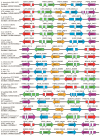Promising Application, Efficient Production, and Genetic Basis of Mannosylerythritol Lipids
- PMID: 38785964
- PMCID: PMC11117751
- DOI: 10.3390/biom14050557
Promising Application, Efficient Production, and Genetic Basis of Mannosylerythritol Lipids
Abstract
Mannosylerythritol lipids (MELs) are a class of glycolipids that have been receiving increasing attention in recent years due to their diverse biological activities. MELs are produced by certain fungi and display a range of bioactivities, making them attractive candidates for various applications in medicine, agriculture, and biotechnology. Despite their remarkable qualities, industrial-scale production of MELs remains a challenge for fungal strains. Excellent fungal strains and fermentation processes are essential for the efficient production of MELs, so efforts have been made to improve the fermentation yield by screening high-yielding strains, optimizing fermentation conditions, and improving product purification processes. The availability of the genome sequence is pivotal for elucidating the genetic basis of fungal MEL biosynthesis. This review aims to shed light on the applications of MELs and provide insights into the genetic basis for efficient MEL production. Additionally, this review offers new perspectives on optimizing MEL production, contributing to the advancement of sustainable biosurfactant technologies.
Keywords: biological activity; biosynthetic pathways; efficient production; fungi; gene clusters; mannosylerythritol lipids.
Conflict of interest statement
The authors declare that there are no competing interests.
Figures





Similar articles
-
[Advance in glycolipid biosurfactants--mannosylerythritol lipids].Sheng Wu Gong Cheng Xue Bao. 2013 Sep;29(9):1223-33. Sheng Wu Gong Cheng Xue Bao. 2013. PMID: 24409686 Review. Chinese.
-
Production of mannosylerythritol lipids and their application in cosmetics.Appl Microbiol Biotechnol. 2013 Jun;97(11):4691-700. doi: 10.1007/s00253-013-4858-1. Epub 2013 Apr 14. Appl Microbiol Biotechnol. 2013. PMID: 23584242 Review.
-
Microbial conversion of glycerol into glycolipid biosurfactants, mannosylerythritol lipids, by a basidiomycete yeast, Pseudozyma antarctica JCM 10317(T).J Biosci Bioeng. 2007 Jul;104(1):78-81. doi: 10.1263/jbb.104.78. J Biosci Bioeng. 2007. PMID: 17697987
-
Import and Export of Mannosylerythritol Lipids by Ustilago maydis.mBio. 2022 Oct 26;13(5):e0212322. doi: 10.1128/mbio.02123-22. Epub 2022 Sep 7. mBio. 2022. PMID: 36069442 Free PMC article.
-
Structural characterization and surface-active properties of a new glycolipid biosurfactant, mono-acylated mannosylerythritol lipid, produced from glucose by Pseudozyma antarctica.Appl Microbiol Biotechnol. 2007 Sep;76(4):801-10. doi: 10.1007/s00253-007-1051-4. Epub 2007 Jul 3. Appl Microbiol Biotechnol. 2007. PMID: 17607573
Cited by
-
Moesziomyces antarcticus MMF1 Has a Role in the Secretion of Mannosylerythritol Lipids.Microorganisms. 2025 Jun 24;13(7):1463. doi: 10.3390/microorganisms13071463. Microorganisms. 2025. PMID: 40731973 Free PMC article.
-
Antioxidant Properties of Biosurfactants: Multifunctional Biomolecules with Added Value in Formulation Chemistry.Biomolecules. 2025 Feb 19;15(2):308. doi: 10.3390/biom15020308. Biomolecules. 2025. PMID: 40001611 Free PMC article. Review.
References
-
- Karnwal A., Shrivastava S., Al-Tawaha A., Kumar G., Singh R., Kumar A., Mohan A., Yogita, Malik T. Microbial biosurfactant as an alternate to chemical surfactants for application in cosmetics industries in personal and skin care products: A critical review. Biomed. Res. Int. 2023;2023:2375223. doi: 10.1155/2023/2375223. - DOI - PMC - PubMed
Publication types
MeSH terms
Substances
Grants and funding
LinkOut - more resources
Full Text Sources
Medical
Molecular Biology Databases

